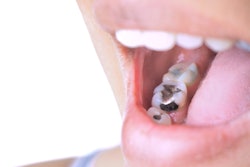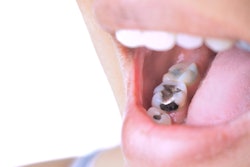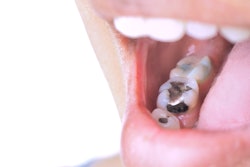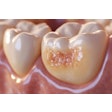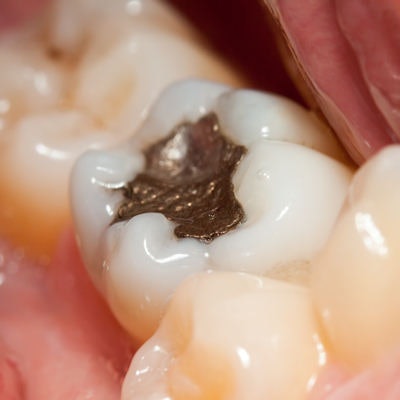
The number of dental amalgam filling surfaces in the mouths of U.S. adults may be linked to high amounts of mercury exposure, according to a study published online in Human and Experimental Toxicology.
In the study, which was weighted to represent more than 158 million U.S. adults, about 10% of people had estimated vapor doses of mercury, a neurotoxin, that exceeded the safety limit set by the U.S. Environmental Protection Agency (EPA). Further, urinary amounts of mercury were estimated to be almost two times higher in adults with at least one amalgam filling compared to those with no amalgam fillings.
"Given that American adults are receiving significant, ongoing exposure to Hg (mercury) vapor from amalgams, careful evaluation of the need to reduce use of amalgams should be considered," wrote coauthor Dr. Mark Geier of the nonprofit Institute of Chronic Illnesses in Silver Springs, MD (Hum Exp Toxicol, June 4, 2022).
Interpreting the weighted-person findings
To explore the impact of mercury exposure from amalgam fillings, researchers reviewed urinary mercury excretion data from U.S. adults who participated in the 2015-2016 and 2017-2018 National Health and Nutrition Examination Survey (NHANES). Men and women between the ages of 21 and 66 were included in the analysis, the authors wrote.
The participants' data were then weighted according to a variable created by the NHANES program to create a final dataset of about 158.3 million weighted persons for the analysis. The authors didn't specify the number of actual NHANES participants used to generate the weighted-person total, but NHANES aims to complete interviews and health examinations with about 5,000 people per year.
Of the 158.3 million weighted persons in the analysis, about 91 million had one or more filled amalgam surfaces. The remaining approximately 67 million had no mercury-containing fillings. The mean number of amalgam surfaces was 4.22, and the maximum number of surfaces was 41.
In weighted persons with at least one amalgam surface, the median amount of mercury in their urine per day was 0.34 µg of Hg per day, an amount significantly higher than the 0.18 µg of Hg per day in weighted-person adults with no amalgam fillings, the authors wrote.
About 16 million weighted persons had daily mercury vapor doses from amalgams that exceeded the EPA's mercury vapor limit of 0.048 µg of Hg/kg body weight/day. Further, 86 million weighted adults, 54% of the sample, had daily mercury vapor doses that surpassed the limit set by California's EPA of 0.005 µg of Hg per kg of body weight per day.
The number of amalgam surfaces was significantly linked to urinary mercury levels in the adjusted and unadjusted models. There were also significant relationships between urinary amalgam based on socioeconomic status and country of birth.
The study was funded with a grant that the Institute of Chronic Illnesses received from the International Academy of Oral Medicine and Toxicology, which has lobbied for tougher restrictions on amalgam fillings for decades. Also, the authors are shareholders in Ireland-based EmeraMed, a company that is developing a compound to treat mercury toxicity.
Further, the study reported data using weighted persons but did not report findings based solely on the NHANES participants. Other limitations included that other sources of mercury exposure, such as from fish, were not considered and that measurements of mercury exposure were done testing levels in urine as opposed to direct measurements.
Paper reflective of a shifting stance on amalgam fillings?
For more than 150 years, amalgam fillings, which are 50% mercury by weight, have been used to fill patients' cavities in the U.S. Though the U.S. Food and Drug Administration (FDA) considers this common tooth filling an effective treatment for adults and children over the age of 6, the FDA recently changed its stance a bit on mercury-containing fillings.
In September 2020, the FDA advised that high-risk individuals, such as pregnant women, should avoid getting dental amalgam fillings "whenever possible and appropriate." For the first time, the agency also listed patients with multiple sclerosis, Alzheimer's disease, and Parkinson's disease as high-risk individuals for amalgam fillings.
Previously, the FDA stopped short of telling patients to avoid mercury-containing fillings. Instead, the agency told high-risk individuals that they may face greater adverse health effects, but they should talk to their dentists about other options, such as non-mercury-containing fillings, like glass ionomer cement fillings.
In February 2021, the FDA released a graphic with its recommendations. The graphic outlines what patients should know about amalgam fillings.
In the future, studies should be conducted to investigate the possible adverse clinical outcomes of amalgam-linked mercury vapor that exceed safety limits, the authors wrote.
"It is important for public health policy, based upon the findings in this study, showing so many American adults are receiving Hg vapor doses in excess of safety limits, that careful attention is focused on the need to reduce amalgam use when considering all sources of Hg exposure," Geier and his colleague wrote.





